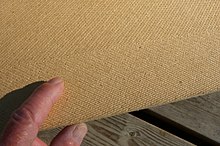
Plywood is a composite material manufactured from thin layers, or "plies", of wood veneer that are glued together with adjacent layers, having both glued with each other at right angle or at 90 degrees angle. It is an engineered wood from the family of manufactured boards, which include medium-density fibreboard (MDF), oriented strand board (OSB), and particle board.

Newsprint is a low-cost, non-archival paper consisting mainly of wood pulp and most commonly used to print newspapers and other publications and advertising material. Invented in 1844 by Charles Fenerty of Nova Scotia, Canada, it usually has an off white cast and distinctive feel. It is designed for use in printing presses that employ a long web of paper, rather than individual sheets of paper.

Drywall is a panel made of calcium sulfate dihydrate (gypsum), with or without additives, typically extruded between thick sheets of facer and backer paper, used in the construction of interior walls and ceilings. The plaster is mixed with fiber ; plasticizer, foaming agent; and additives that can reduce mildew, flammability, and water absorption.
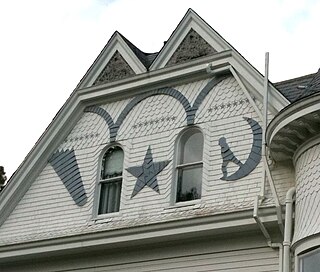
Siding or wall cladding is the protective material attached to the exterior side of a wall of a house or other building. Along with the roof, it forms the first line of defense against the elements, most importantly sun, rain/snow, heat and cold, thus creating a stable, more comfortable environment on the interior side. The siding material and style also can enhance or detract from the building's beauty. There is a wide and expanding variety of materials to side with, both natural and artificial, each with its own benefits and drawbacks. Masonry walls as such do not require siding, but any wall can be sided. Walls that are internally framed, whether with wood, or steel I-beams, however, must always be sided.

A mop is a mass or bundle of coarse strings or yarn, etc., or a piece of cloth, sponge or other absorbent material, attached to a pole or stick. It is used to soak up liquid, for cleaning floors and other surfaces, to mop up dust, or for other cleaning purposes.

Particle board, also known as particleboard, chipboard, and low-density fiberboard, is an engineered wood product manufactured from wood chips and a synthetic resin or other suitable binder, which is pressed and extruded. Particle board is often confused with oriented strand board, a different type of fiberboard that uses machined wood flakes and offers more strength.

Hardboard, also called high-density fiberboard (HDF), is a type of fiberboard, which is an engineered wood product. It is used in furniture and in the construction industry.

Fiber cement siding is a building material used to cover the exterior of a building in both commercial and domestic applications. Fiber cement is a composite material made of cement reinforced with cellulose fibers. Originally, asbestos was used as the reinforcing material but, due to safety concerns, that was replaced by cellulose in the 1980s. Fiber cement board may come pre-painted or pre-stained or can be done so after its installation.

Papercrete is a building material that consists of re-pulped paper fiber with Portland cement or clay and/or other soil added. First patented in 1928, it was revived during the 1980s. Although perceived as an environmentally friendly material due to the significant recycled content, this is offset by the presence of cement. The material lacks standardisation, and proper use therefore requires care and experience. Eric Patterson and Mike McCain, who have been credited with independently "inventing" papercrete, have both contributed considerably to research into machinery to make it and ways of using it for building.

A batten is most commonly a strip of solid material, historically wood but can also be of plastic, metal, or fiberglass. Battens are variously used in construction, sailing, and other fields.
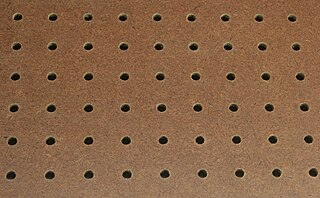
Perforated hardboard is tempered hardboard which is pre-drilled with evenly spaced holes. The holes are used to accept pegs or hooks to support various items, and perforated hardboards are therefore used for purposes such as tool boards in workshops. Peg-Board is an expired trademark used as a brand name by the Masonite Corporation, first used in 1962, which is often used as a generic term for perforated storage boards made of hardboard, wood, metal, or other material. It is commonly used in retail settings along with steel rods sticking out to hold peggable products such as bagged potato chips, printer ink, and action figures.
Paper composite panels are a phenolic resin/cellulose composite material made from partially recycled paper and phenolic resin. Multiple layers of paper are soaked in phenolic resin, then molded and baked into net shape in a heated form or press. Originally distributed as a commercial kitchen surface in the 1950s, it has recently been adapted for use in skateboard parks as well as various other applications, such as residential counters, cabinetry, fiberglass cores, guitar fingerboards, signage, exterior wall cladding, and a variety of architectural applications.

Homasote is a brand name associated with the product generically known as cellulose-based fiber wall board, which is similar in composition to papier-mâché, made from recycled paper that is compressed under high temperature and pressure. Homasote contains no adhesives. It is held together by the surface tension between the paper fibers, a process that is augmented by hydrogen bonding and the presence of a wax binder. It is available in multiple thicknesses and comes in sheets 4 by 8 feet. The Homasote Company operates a 750,000-square-foot (70,000 m2) factory in the West Trenton section of Ewing Township, New Jersey.

Fireproofing is rendering something resistant to fire, or incombustible; or material for use in making anything fire-proof. It is a passive fire protection measure. "Fireproof" or "fireproofing" can be used as a noun, verb or adjective; it may be hyphenated ("fire-proof").

Fiberboard or fibreboard is a type of engineered wood product that is made out of wood fibers. Types of fiberboard include particle board or low-density fiberboard (LDF), medium-density fiberboard (MDF), and hardboard or high-density fiberboard (HDF).
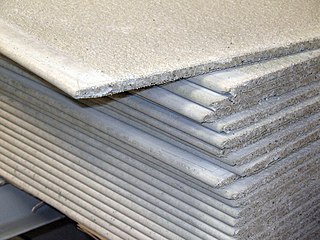
A cement board is a combination of cement and reinforcing fibers formed into sheets, of varying thickness that are typically used as a tile backing board. Cement board can be nailed or screwed to wood or steel studs to create a substrate for vertical tile and attached horizontally to plywood for tile floors, kitchen counters and backsplashes. It can be used on the exterior of buildings as a base for exterior plaster (stucco) systems and sometimes as the finish system itself.
Masonite International Corporation is a designer, manufacturer and distributor of interior and exterior doors for the new construction and repair, renovation and remodeling sectors of the residential and non-residential building construction markets. Founded in 1925 in Laurel, Mississippi, It currently serves approximately 8,500 customers in 60 countries and is headquartered in Tampa, Florida.
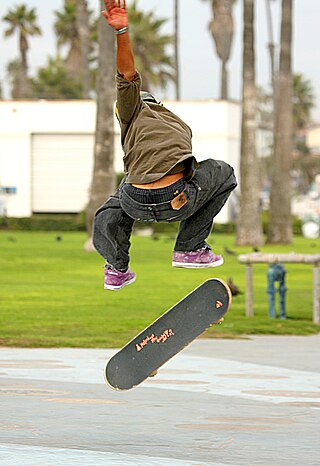
A skateboard is a type of sports equipment used for skateboarding. It is usually made of a specially designed 7–8-ply maple plywood deck and has polyurethane wheels attached to the underside by a pair of skateboarding trucks.
United States v. Masonite Corp., 316 U.S. 265 (1942), is a United States Supreme Court decision that limited the scope of the 1926 Supreme Court decision in the General Electric case that had exempted patent licensing agreements from antitrust law's prohibition of price fixing. The Court did so by applying the doctrine of the Court's recent Interstate Circuit hub-and-spoke conspiracy decision.
In visual arts, the support is a solid surface onto which the painting is placed, typically a canvas or a panel. Support is technically distinct from the overlaying ground, but sometimes the latter term is used in a broad sense of "support" to designate any surface used for painting, for example, paper for watercolor or plaster for fresco.

